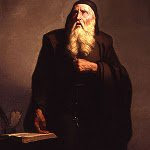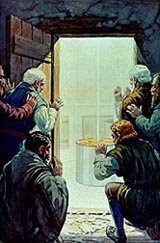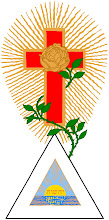Peregrin Wildoak, in a response to my blogpost on the Primordial vs. Temporal Traditions, wrote a couple of days ago:
The way ancient and pre-modern folk understood the world is very different to the way we understand it.
We cannot easily escape our culture and the paradigm with live in, no matter how much we try.
To down play on the Traditionalist concept of original Egyptian Mysteries, referring to it as a “overlaying the mythic Egypt atop the historical Egypt”, he cited his own buddy Caroline Tully, what he refers to as the “Pagan scholar”, and her book Ten Years of Triumph of the Moon, in which she critizies the authencity of McGregor Mathers’ Rites of Isis in Paris, which she refers to as a “reconstruction of the Egyptian Mysteries”. She writes:
Undoubtedly inspired by Herodotus’ application of the Greek term ‘mysteries’ to Egyptian religion (Histories. 2.171), Diodorus’ erroneous claim of an Egyptian origin for the Greek Mysteries of Eleusis when in fact it was the other way around (Lib. 1.29.2,4; Martin 1987: 78), Apuleius’ Metamorphoses (11.21–6), and Plutarch’s mention of Isis and Osiris initiations and mystic rites (De Iside. 2, 25, 28), the main problem with the Mathers’ attempt at creating this initiatory system was that there were no Egyptian Mysteries to begin with.
While there certainly were Graeco-Roman mysteries of the Hellenised Isis, the idea that there were ancient Egyptian ‘mysteries’ originated with Greeks like Herodotus misunderstanding the Egyptian cult of Osiris at Abydos and interpreting it as ‘mysteric’ because it was carried out by specially consecrated priesthood, unlike the part-time priests of Greece (Burkert 1987: 39–40; Lefkowitz 1997: 93). While access to the inner recesses of the Egyptian temple was limited to the priesthood, festivals were open to the public, not restricted to groups of initiates (Morenz 1973: 89–90).
Mr. Wildoak’s punch line is that the Golden Dawn, for the same reasons as Golden Dawn founder and Chief MacGregor Mathers’ Rites of Isis is a “reconstruction”, actually don’t use any Egyptian Gods. He says:
Really there are only modern interpretations and adaptations of Graceo-Coptic Gods. And some of those adaptations were based on Mathers’ personal assumptions and mindset of what Egypt was.
First of all, it is true that we are all prisoners of the cultural paradigm in which we are living. This also equally applies to academics, scientists and scholars. Somehow there is this myth floating around that a scientist and scholar, in virtue of his academic education and merits, is exempt from this paradigm. This is of course utterly false.
Today we live in a post-modernist paradigm in which all “truths” are thrown out with the bath water and everything is relativized. We also live in the paradigm in which we, as members of post-modernist humanity and society, believe us to know more than humanity ever has, especially compared to the “superstitious” ancients, in virtue of our modern scientific methods.
Today we live in a post-modernist paradigm in which all “truths” are thrown out with the bath water and everything is relativized. We also live in the paradigm in which we, as members of post-modernist humanity and society, believe us to know more than humanity ever has, especially compared to the “superstitious” ancients, in virtue of our modern scientific methods.
 |
| Golden Dawn God-Form |
It is also very obvious for all serious students of the Golden Dawn Tradition that the God-Forms, as they are deptictied in the so-called “Z” document and attached papers, are a modern magical adaptation. But that doesn’t imply that there still aren’t any traces left from original ancient concepts. As I said in my original blog post, in the God-Forms of the Golden Dawn we see a temporal tradition. But behind this cultural coating there is an essence which breaths the Primordial Tradition into the outer temporal shells. The “Z” document surely enough is based upon the Egyptian Book of the Dead. The fact is that this document, and its teachings on the Egyptian God-Forms, originated from the Third Order; it wasn’t MacGregors’ own invention. And this same Third Order happens to be a true custodian and lineal descendent of these original Egyptian Mysteries.
 |
| The Rites of Isis |
Secondly. I bet that Caroline Tully hasn’t seen any copies of the Rites of Isis, as written by MacGregor Mathers. In fact very few have been so fortunate who are still living today, even though it is still possible although only to a select group of initiates. So how can Caroline Tully even say anything of its varacity? Non in my opinion. She simply assumes that it all was a reconstruction in MacGregor Mathers’ mind, as she regards anything pagan today. A pet theory of hers and that of Hutton, et al.
Being children of the post-modernist era, occultists and scholars alike of today don’t believe in a authenic and living tradtion. They are driven by a relentless scepticism and have a natural tendency of being hostile against any notions contrary to what academically may be proven. Most of them believe that there are no other initiatic traditions or organisations other than those that have already been made public. I.e. Golden Dawn post-modernist students believe that the Hermetic Order of the Golden Dawn and its initiatic system up to and including the Adeptus Minor Grade was the final contribution and crowning of the system, and that it was reconstructed by W.W. Westcott and S.L. MacGregor Mathers. Any notions of an authentic source more advanced that the Second Order of the R.R. et A.C. are considered to be baroque.
This also counts for MacGregor Mathers’ revival of the Rites of Isis which are regarded to be a reconstrution. But only because Aleister Crowley did an actual reconstruction of the Eleusinian Mysteries in his Rites of Eleusis, which was nothing of the kind but rather a series of Planetary invocations using classical Ceremonial Magic as a framework, although I bet that Crowley were inspired by MacGregor Mathers and his Rites of Isis, the post-modernist students and scholars assume MacGregor Mathers to have done something along the same lines as Crowley.
Mind you, the actual Isiac mysteries are alive and well in Europe, limited to a small group of initiates. Considering the level of MacGregor Mathers’ initiations, including that continental and ancient fraternity referred to by MacGregor Mathers as the Third Order, I doubt that he didn’t have any access to these as well.
 |
| Hermanubis |
So I consider it to be but a deliberate red herring used by Mr. Wildoak when he claims the Egyptology of the Golden Dawn, and its associated traditions, to have a Greek origin. In fact they are at least Hellenic, which is a blend of Greek and Egyptian traditions and concepts. I must stress this; Hellenism isn’t solely a Greek phenomenon – it is a Graeco-Egyptian one. We are actually talking about the era of the Ptolemic dynasty of Egypt, while being the result of a Macedonian take-over still integrated fully with the original Egyptian civilization and culture, taking care not to oppose the highly conservative Egyptian population.
Concerning the Egyptian origins of the Eleusinian Mysteries, it seems that there is no such consensus amongst scholars as Mr. Wildoak would like you to believe. I.e. in his rhetoric we see yet another example of the use of red herrings. Let me quote from one source:
In the early part of this century, [Paul François] Foucart theorized, on the basis of statements by classical authors (e.g., Herodotus Bk. 2) as well as the discovery at some Mycenaean sites of Egyptian figurines and small artifacts, that the cult of Demeter in Greece originally derived, in whole or in part, from Egypt. Further support for this hypothesis comes from certain remarkable parallels between the myth of Isis (especially in the version presented by Plutarch in his Isis and Osiris, chs. 15 and 16) and that of Demeter (as recounted in the “Hymn to Demeter,”). Among the details of these parallels are episodes in both stories involving infant princes who almost gain immortality—but not quite—at the hands of the respective goddesses.
On the basis of these correspondences, Foucart and his followers concluded that the Mysteries at Eleusis originally must have come from Egypt (Foucart 2-23; Magnien 44-46). Yet the fact that the sanctuary ruins in Eleusis evidently go back centuries earlier than the Hymn itself, and that excavations have unearthed no Egyptian artifacts there from that period, militates against this hypothesis (Mylonas 15, 276). On the other hand, since we know that Greek colonists and mercenaries had settled in Lower Egypt by the seventh century BCE (Leclant 245), it is reasonable to surmise that these Greek and Egyptian fertility goddesses had already begun to penetrate each other’s cults and mingle in the minds of worshippers, perhaps by way of Cretan influences. There is still no consensus about this and it remains a topic of lively debate.
My personal opinion regarding this cross-cultural mixing, based upon the traditional history that I have been taught, is the following: The mysteries of Egypt were overly patriarchal and centered around the cult of Osiris. Isis was an important character in this story, but only in a supporting role as the faithful wife and restorer of Osiris’ life so that he might be resurrected to fulfil his destiny.
 |
| The hellenicised Isis |
On the other hand, the mysteries of Greece were overly matriarchial and based on the earlier shamanic mother goddess cults. Both mysteries were agricultural, based on the Solar cycles of death and resurrection, the former centred on the Solar force itself, the latter on the terrestrial and Lunar (as receivers of the Solar currents), althought there is evidence to assume Osiris also to be a earth ferility god. During the Hellenistic period these two mysteries met and cross-pollonized. By now the Eleusinian Mysteries may have taken up influences from the Egyptian Isis, if not earlier. On the other hand perhaps the Isiac mysteries grew in prominence in Hellenistic Egypt and Greece because of the influences of the Eleusinian Mysteries. They surely were related.
Thus, it is fruitless to look upon this as a one way transmission; it is more fruitful to see it as a reciprocal influence, typical of the Ptolemaic dynasty. The proper academic stance on this subject is that we may never know the truth regarding who made who, simply based on archaeology and study of classical literature. The best position is to suspend judgement and be open-minded to either possibility.
Granted, the mystery plays of the pre-hellenistic Egypt were public, while the Eleusinian Mysteries in Greece were secret. Still the Egpytian plays did conveyed a mystery to the spectators. Remember that Egypt was a theocracy and involved the entire population in its state sanctioned cults; magic was a common and everyday event. Still not all of that was open do the public. Not even the public festivals were that public, as can be seen in this quote from another source:
Thus, it is fruitless to look upon this as a one way transmission; it is more fruitful to see it as a reciprocal influence, typical of the Ptolemaic dynasty. The proper academic stance on this subject is that we may never know the truth regarding who made who, simply based on archaeology and study of classical literature. The best position is to suspend judgement and be open-minded to either possibility.
Granted, the mystery plays of the pre-hellenistic Egypt were public, while the Eleusinian Mysteries in Greece were secret. Still the Egpytian plays did conveyed a mystery to the spectators. Remember that Egypt was a theocracy and involved the entire population in its state sanctioned cults; magic was a common and everyday event. Still not all of that was open do the public. Not even the public festivals were that public, as can be seen in this quote from another source:
At these times, ordinary people might witness the procession of a deity, although it would most frequently be from a distance and usually the actual image of the god would not be visible to them.
The daily cult ritual was a secluded and secret affair, reserved to the priests who held the images of the gods locked up in special shrines, called naos. Thus like with the religious cult of Israel (which clearly drew its inspiration from the Egyptian cults, not only in this respect), the Holy of Holies or Sanctuaries were prohibited territory for the common Egyptian. Thus secret practices were reserved for the priests and priestesses, as is shown in this source which I quote:
The involvement of the general public in the temple ceremonies was small. Ordinary people had no access to the inner regions of the temples which could only be entered after elaborate purification rituals. Offerings to the gods, food, flowers, or votive stelae, could be made in the outer temple courts.
Also concepts of the Egyptian theology amongst the priests and priestesses were different compared to the popular views held by the common Egyptians. There surely was a secret lore that was only reserved to the priestly caste and the royalty. In the New Kingdom priesthood was, like royalty, hereditary. Many priests and priestesses were members of the royal family even. Magic was closely associated with the priesthood, although there existed a popular or common form of magic as well. Thus, as the daily cult ritual – which used a magical formula – was a secret affair, there truly was an esoteric tradition in Egypt.
 |
| The Naos of the Edfu Temple which housed the image of Horus |
However, the esoteric tradition extended beyond that of the daily cult rituals. There also existed an alchemical tradition, mainly reserved for the royalty in its inception (in a similar way as there also existed an Daoist internal alchemy reserved for the Chinese Emperor), although it later became part of the innermost initiatic secrets of the priestly caste.
Egypt was very exotic and commonly regarded as mysterious, and magical, amongst the surrounding ancient peoples, not only to the Greeks and Romans. The Babylonian Talmud, as an example, says the following:
Ten measures of sorcery descended to the world; Egypt took nine and the rest of the world took one.
Many of the greatest Greek philosophers travelled to Egypt and brought with them a new wisdom, such as Thales, Pythagoras and Plato, at least if we are to believe their own accounts and that of their disciples. Greek philosophy as we know it wouldn’t had been the same without the Egyptian influence. Even the New Testament states that:
...Moses was learned in all the wisdom of the Egyptians, and was mighty in words and in deeds. (Act 7:22)
So there is absolutely no empirical basis for the post-modernist concept that there were no esoteric and secret initiatory mysteries surrounding the priests and priestesses of Egypt prior to the Hellenistic era; the empirical information rather supports the opposite view. And now, when this fallacy has been disproven what more will we see coming from the post-modern reconstructionist “scholars”? That there were no magical nor any alchemical tradition in Egypt as well? Frankly, I wouldn’t be surprised…
S∴R∴





























